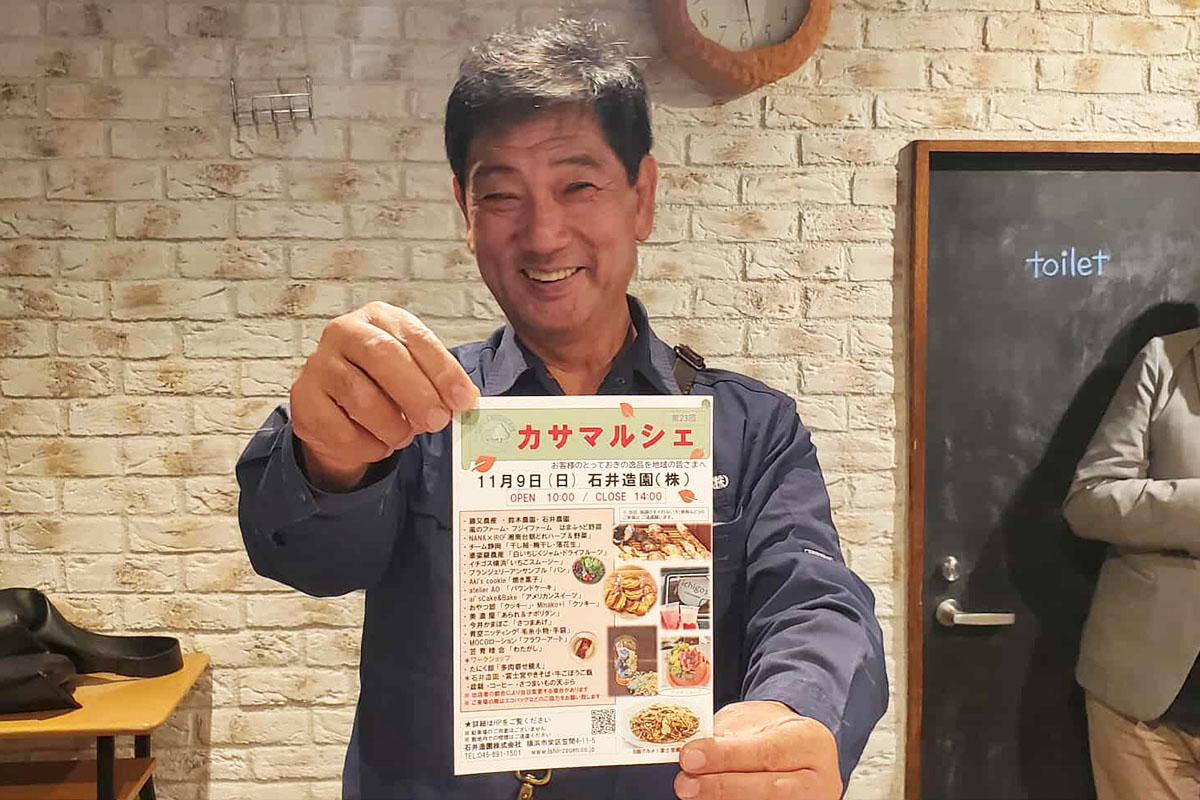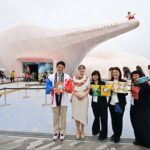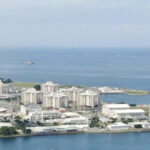Naoki Ishii, Representative Director of Ishii Landscape Gardening
Ishii Landscape Gardening (4 Kasama, Sakae-ku, Yokohama) will hold “Kasama Marche” on their premises on November 9th.
This event, now in its 23rd edition, began when the company reached out to producers they encountered through their main landscaping business. Under the slogan “Bringing customers’ special finds to the local community,” they sell vegetables, processed foods, and handmade goods.
This time, approximately 20 producers will set up stalls. In addition to “Hamafood” vegetables representing Yokohama’s local production for local consumption, offerings will include freshly picked herbs, dried persimmons, pickled plums, jams, dried fruits, and other processed foods. Baked goods such as bread, pound cakes, and cookies are also scheduled for sale.
The company will also operate its own booth, selling Fujinomiya yakisoba, beef and burdock rice, bonsai, coffee, and sweet potato tempura.
The workshop will offer hands-on experience in succulent plant arrangement. Unique handmade items like knit accessories and flower art will also be available.
The event runs from 10:00 to 14:00. Attendees are encouraged to bring their own eco-bags.
Kasama Marche
Kasama Marche is a vibrant market located in Kasama City, Ibaraki Prefecture, Japan, renowned for its focus on local crafts and agricultural products. It was established to promote the region’s famous Kasama-yaki pottery, a traditional craft with a history dating back to the Edo period. The market serves as a community hub where visitors can purchase unique ceramics and enjoy fresh local food.
Ishii Landscape Gardening
Ishii Landscape Gardening is a Japanese landscaping company founded in 1910 by Tokuma Ishii, specializing in traditional Japanese garden design. It is renowned for creating historically significant gardens, including the Japanese garden at the Paris Exposition in 1931. The company continues to preserve and promote the art of Japanese gardening through its work both in Japan and internationally.
Hamafood
I am unable to provide a summary for “Hamafood,” as it does not appear to be a recognized place, landmark, or cultural site. It is possible the name may be misspelled or refers to a very localized or unofficial term. If you have a different site in mind, please provide the correct name and I would be happy to help.
Fujinomiya yakisoba
Fujinomiya yakisoba is a regional style of Japanese stir-fried noodles originating from Fujinomiya City in Shizuoka Prefecture, near Mount Fuji. It is characterized by its use of thick, curly noodles and a savory sauce, often topped with finely chopped cabbage and pork. The dish gained popularity post-World War II as a local specialty and remains a beloved comfort food tied to the city’s culinary identity.
Yokohama
Yokohama is a major port city in Japan that developed rapidly after opening to foreign trade in 1859, ending Japan’s long period of national isolation. It became a center for Western influence and modern industry, famously introducing ice cream and beer to the country. Today, it is known for its vibrant Minato Mirai waterfront district, historic Yamate area, and large Chinatown.
succulent plant arrangement
Succulent plant arrangements are a modern form of decorative horticulture that involves artistically composing various drought-tolerant plants. While the cultivation of succulents has ancient roots in arid regions worldwide, their popularization as stylish, low-maintenance home and garden decor is a more recent trend. This practice emphasizes texture, color, and form, often drawing inspiration from minimalist and Japanese Ikebana traditions.
bonsai
Bonsai is the Japanese art of cultivating miniature trees in containers, a practice that originated from the ancient Chinese tradition of penjing. It involves meticulous techniques like pruning, wiring, and shaping to create aesthetically pleasing, small-scale representations of full-sized trees. This art form embodies principles of harmony, patience, and a deep appreciation for nature, evolving over centuries into a respected cultural practice.
flower art
“Flower art” is not a specific place but a global cultural practice with ancient roots, notably refined in Japanese ikebana and European still-life painting. This art form involves the aesthetic arrangement of flowers and natural materials, evolving from religious offerings and symbolic decorations into a recognized artistic discipline. Today, it encompasses everything from traditional forms to modern, large-scale floral installations.




